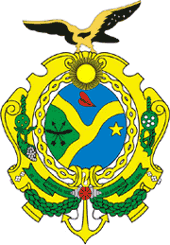
The history of Amazonas is the result of treaties, religious missions and a few indigenous rebellions in the Amazon territory. Initially, under the Treaty of Tordesillas, the site belonged to the Spanish Kingdom, but was later annexed by the Portuguese Crown.[1] The state's international borders, undefined after Brazil's independence in 1822, were demarcated during the signing of the Treaty of Bogotá. Archaeological research suggests past occupations by Paleo-Indian hunter-gatherer groups, dated around 11,200 years before the present day.[2][3]
The period of greatest human development in the lowlands of the Amazon is known as the late pre-Columbian, which coincides with the European invasion in the 16th and 17th centuries and the socio-political dismantling of complex societies that occupied the channel of the Amazon river and inland. The territory was once part of a Portuguese administrative unit called the State of Grão-Pará and Maranhão, whose capital was initially São Luiz do Maranhão, but was transferred to the city of Santa Maria de Belém do Grão-Pará (now Belém), becoming the State of Grão-Pará and Rio Negro after the administrative foundation of the Captaincy of São José do Rio Negro, based in Barcelos. Between the mid-18th and 19th centuries, Barra do Rio Negro (now Manaus) was elevated to the category of village and became the administrative capital of the Captaincy of Rio Negro.[4]
After the dismemberment of the Province of Grão-Pará, the state was designated São José da Barra do Rio Negro on September 5, 1850. The new province was named Amazonas by Dom Pedro II in reference to the river of the same name, which was called so by the Spanish in the expeditionary historical accounts of Friars Gaspar de Carvajal and Francisco de Orellana. When Orellana traveled down the present-day Amazon river in search of gold and spices in 1541, heading for the Atlantic Ocean, the stream was called Grande, Mar Dulce or even Río de la Canela, because of the large cinnamon trees found there.[5][6]
However, the main name given to the river was Rio de las Amazonas, due to the supposed victorious resistance of warrior natives against the invaders, reported by the Spanish expeditionaries. The information was so relevant that the Hispanic crown became aware of it through stories that referred to the river as the Amazon in reference to the myth of the Amazons in Greek mythology. The expeditionary Orellana was given the right to explore the new lands, a fact that was not realized due to his disappearance at the mouth of the river.[6]
- ^ "Tratado de Tordesilhas". Arqnet. Retrieved 2023-10-18.
- ^ "Tratados de Fixação de Limites Territoriais". Atlas FGV. Retrieved 2023-10-18.
- ^ "As fases de ocupação humana da Amazônia". Recanto das letras. Retrieved 2023-10-18.
- ^ Santos, Francisco Jorge dos (2006). História do Amazonas. MemVavMem.
- ^ Carvajal, Gaspar de. Descubrimiento del río de las Amazonas. BDH.
- ^ a b Guedelha, Carlos Antônio Magalhães (2013). "A METAFORIZAÇÃO DA AMAZÔNIA EM TEXTOS DE EUCLIDES DA CUNHA" (PDF). UFSC.
